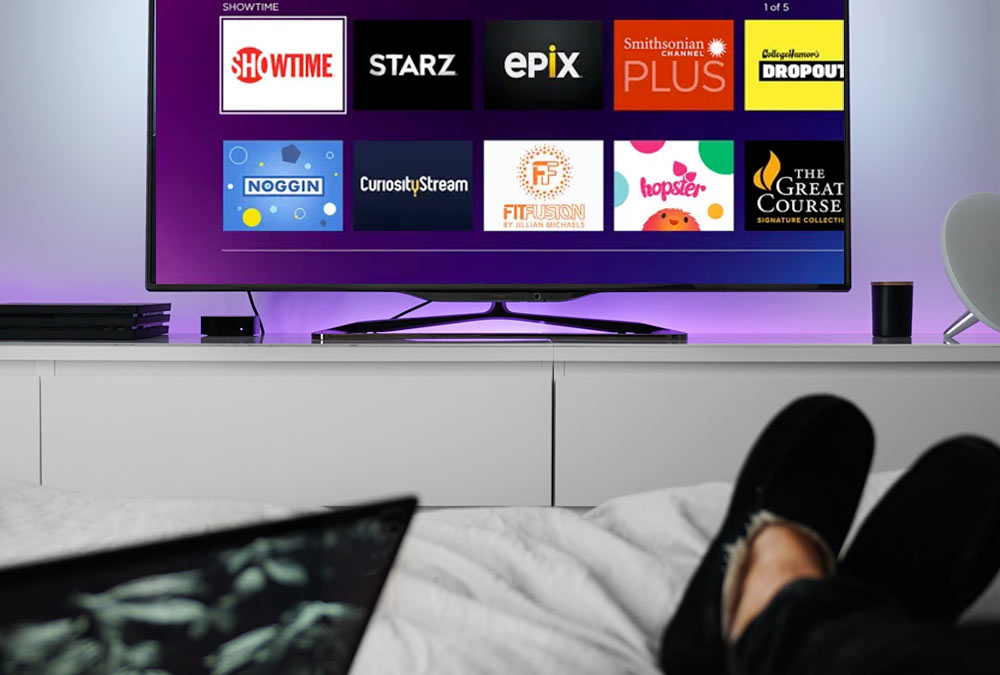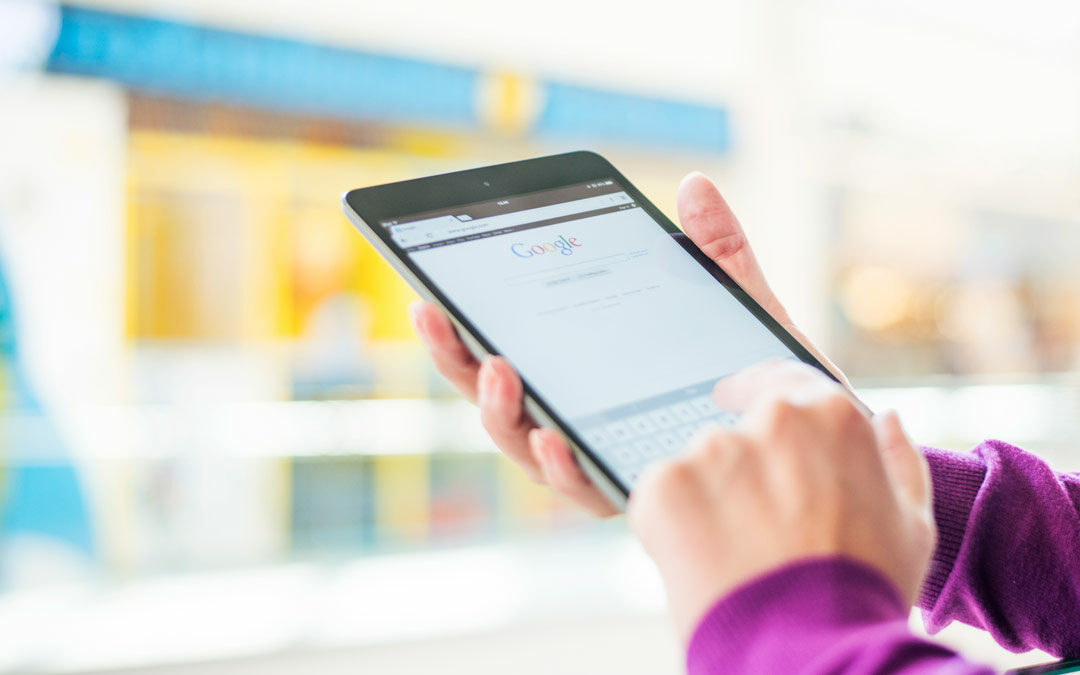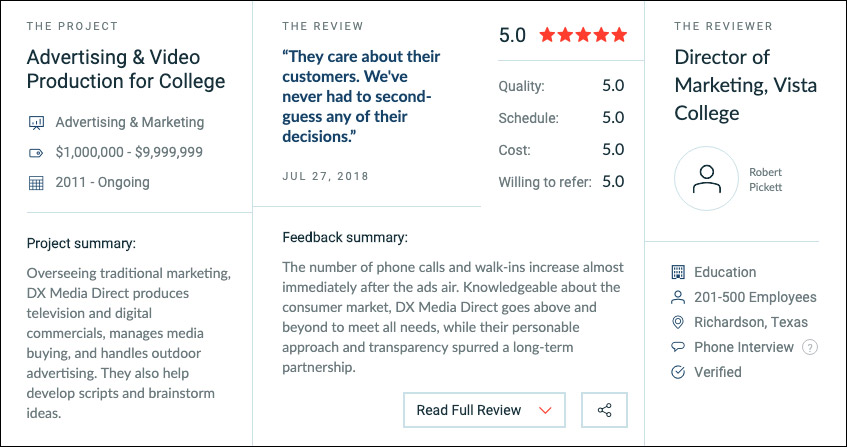
May 25, 2021 | CTT / OTT Advertising, Digital Marketing, Direct Response Advertising
If you’re considering using video content in your social media advertising, one of the most important questions is how long does video content last? Will it drive views and sales forever, or is there an expiration date? Here are some of the things you should consider.
Why Video Content?
Simply put, video content is where customers are. Video content will soon make up over 82% of all consumer internet traffic. You can see this by just going around to different social media platforms or news websites. People aren’t posting written content. They’re posting videos. If you want your ad to be seen, you need to be posting videos as well.
How Long is Video Content Effective?
As social media advertising makes more use of video, video is starting to blend in with other forms of advertising as well as all of the other content out there. That means that in many cases you only have a limited amount of time to grab attention with your ad. QuickFrame has released a number of statistics on how video ads perform.
Five Days
Video content is most effective within the first five days of release by all measures. That includes views, conversions, and how many people watched the video to completion. Once you get past the fifth day, the drop in performance is about five percent per day.
Eight Days
The eighth day is when video ads typically start to seriously underperform. Only about two-thirds of users will watch at least 25% of the video. Just 1.5% will watch the entire video.
Fourteen Days
By the second week, most videos have lost effectiveness. Viewership continues to drop by at least 3% per day. Conversions also start to drop. The average conversion rate in the initial days is just 0.32%. By the second week, conversions are nearly zero. That increases the cost of acquisition by 18%.
Three Days
If you’re trying to market an app download, you have even less time. Video audiences are typically willing to download an app within the first three days of an ad. After that, install rates start to drop and are 33% lower by the end of the month. This, in turn, increases your cost per impression.
Do Consumers Become Blind to Video Ads?
One reason that the performance of video content drops off is consumers start to become blind to ads. This comes from both seeing the ad in multiple places as well as from the sheer number of online ads in general.
The average user has eight different social media accounts. Videos may also appear on traditional broadcast TV or in online streaming services. That means that many of your ad impressions could be going to someone who has already seen your ad multiple times. Viewers start to tune out that ad or have already decided not to buy. This also gets them in the habit of tuning out ads in general.
That general ad blindness is also a cause for concern. When video ads were rarer in social media advertising, they were a way to catch attention on their own. Today, you need to find a way to get users to break that habit of automatically clicking past videos.
Are There Privacy Concerns in Video Ads?
One way to combat ad fatigue is by making sure consumers don’t keep seeing the same ad over and over again. Unfortunately for marketers, this type of cross-platform tracking has come under fire from multiple directions. Consumers don’t like the idea of being tracked and install blocking software to keep marketers from identifying them as they move from one platform to the other.
Various levels of government have also passed consumer privacy laws that make tracking impossible without affirmative consent. With consumers not wanting to participate, the costs of compliance can outweigh the potential benefits of leaving tracking in place.
In addition, even seemingly effective tracking campaigns can have hidden challenges. For example, say you are buying a new car. As you visit car review websites and dealership websites, automated marketing campaigns start to show you more ads related to buying a new car no matter what website or social media platform you’re on. If you see a new video about a car you’re considering, there’s a pretty good chance you’ll watch it.
The first problem for marketers is controlling these ads from repeating too many times. If tracking isn’t effective, one solution might be to put out a wider variety of videos to decrease the repetition. The second problem is that online campaigns can’t identify when you’ve gone to a physical dealership to buy or have decided not to buy. The answer to this second challenge is primarily limiting the length of your campaign.
What Exactly Are You Advertising?
How long a video ad will remain effective will depend on exactly what you’re advertising and the goal for your campaign. While many ads expire quickly, it is also possible to develop evergreen videos in certain situations.
For example, say you’re advertising a haunted house on Halloween night. You’ll probably want to start up your ad campaign sometime in October. Exactly when is a balancing act. Start too early and you risk people seeing the ad too many times. Start too late and they may have other plans already. And if you do start early, you have no idea if low conversions are because people aren’t interested or if it’s still too early for them to make plans. No matter what happens, on November 1st, your ad has served its purpose.
Now let’s say you’re advertising for a hardware store. You might have special events, sales, or new product launches that are more timely by nature. These videos will have short expiration dates. Recurring seasonal videos, such as getting ready for summer, might last from year to year. However, you might want to refresh them each year to create more buzz. A type of evergreen content that will be more likely to stick in search engines and continue to drive customers to your store is a how-to series on basic home improvements and repairs.
Conclusion
When you launch video content in your social media advertising, you’re racing against the clock before it loses effectiveness. Exactly how long your video will last depends on your audience, what you’re selling, and the goal for each video.
To learn more about video marketing or to get ideas for a video campaign, talk to DX MediaDirect.

May 4, 2021 | CTT / OTT Advertising, Direct Response Advertising
The shift toward streaming has been profound, with 90% of Americans aged 13-54 now streaming their favorite shows. In recent years, Connected TV and streaming were growing. However, the pandemic pushed this trend into overdrive. In the past year, there has been a multi-generational movement. This movement is reinventing how, what, where, and when we watch. Content is now on-demand and limitless to the streaming generation, creating an immense opportunity for businesses — especially those who want to optimize their advertising and marketing strategies.
The Streaming Generation and Connected TV
Connected TV has left analog television in the dark ages, as it allows viewers to watch what they want, whenever they want. Connected TV (CTV) is television that connects to the internet, allowing viewers to stream digital content at their convenience, through apps on Apple TV or a smart TV, as well as through gaming consoles and devices such as Roku.
CTV was gaining popularity for years. However, the recent pandemic caused unprecedented growth. The number of CTV households achieved its 5-year growth projection in just three weeks during the “shelter-in-place” order. Online content streaming increased by 70%, with 60% of viewers adding a streaming service since the beginning of 2020. Also, 91% of the streaming generation would rather give up their social media, music streaming service, favorite food, and favorite brand before they gave up their video streaming service.
Connected TV Has Revolutionized Advertising
Connected TV advertising has been building over the past few years. However, there was a clear tipping point in 2020 — and this trend is unlikely to reverse. Research shows that 15% of consumers canceled their cable subscriptions. During this time, advertisers could reach over 84 million households via connected TV. In 2021, an additional 27% of consumers plan to ditch cable services in favor of connected TV services.
Business owners, advertisers, and marketing teams have recognized these trends, shifting their budgets. Those who are not risk being left behind. After all, 43% of marketers identified CTV as the number one channel for brand storytelling and overall brand awareness, followed by social media (29%) and traditional, linear TV (26%).
Those who see the potential and have already experienced a significant ROI are adapting, becoming more and more creative. Since the viewing experience on CTV differs from traditional TV, ads are now shorter and more flexible. This is creating a trickle-down effect, as companies bring on new talent and training programs to become more fluent in CTV.
These are the facts:
- Consumers are moving away from cable services because 50% think it’s too expensive, with 48% not getting enough value for their money. Nearly 38% say they are attracted to streaming services because they offer a better viewing experience.
- Currently, less than half (49%) of TV viewers still subscribe to cable services— and 27% of these viewers plan to cancel their cable subscription this year.
- It is not just millennials who are canceling cable services The data shows that 20% of those 55 and older plan to cancel their cable services in 2021, up from 8% at the end of 2020.
- Perhaps one of the most significant findings is that 79% of people who have now stopped paying for cable are unlikely to subscribe again. This is incredibly telling, as this shift means that marketers will need to rethink how they engage with both their current and prospective customers.
Advertising on Connected TV and OTT
CTV/OTT advertising uses targeting capabilities that allow advertisers, like yourself, to show different ads to viewers who are watching the same show. This helps you save money and maximize your budget because your ads are shown to an intended audience. This is just one reason why CTV offers a potentially superior investment compared to traditional TV ads.
Some benefits of incorporating Connected TV/OTT advertising into your business plan include:
- More effective targeting— Combining the experience of TV with digital advertising technology, you can build custom audiences based on demographics and behavioral attributes. This allows you to customize your message, created targeted ad campaigns that increase conversion rates.
- Greater flexibility — See what works and what doesn’t, without committing to a “block of time” like you would with traditional TV advertising.
- More accurate analytics— With CTV, you can measure ad performance, tracking a wide range of metrics, including website visits.
- No need to worry about third-party cookies— The death of third-party cookies has many marketers concerned, but luckily, CTV is a channel that will remain unaffected.
Recommended reading: How to Develop Creative Advertising That Motivates Customers to Try and Buy
Top Criteria for TV Ad Buyers in 2021
Considering 95% of marketers reported CTV achieved their desired key performance indicators, it’s time to consider the value of Connected TV advertising.
If you’re wondering where others stand on this movement, here are the areas that matter most to TV ad buyers in 2021:
- 30% want the flexibility to cancel without penalty
- 30% want the ability to connect their investments to measurable business outcomes
- 22% want to change campaigns quickly in-flight
- 18% want the ability to stop/start quickly
Dive deeper into the type of CTV advertising support that converts!
How DX Media Direct Can Help
Not sure how to implement new OTT and CTV strategies into your current marketing strategy, but want to act fast?
Looking for cost-effective ways to put your brand on sites like Hulu, Apple TV, Discovery +, and YouTube TV?
DX Media Direct is a full-service direct response advertising agency that can help you achieve a measurable return on your advertising investment. We have over 25 years of experience helping brands of all sizes succeed.
Four key components will help drive the success of your CTV campaign:
- Technology
- Data science
- An experienced CTV/OTT media buying team
- Volume discounts
At DX Media, we can help with all the above. We are experts in this space, offering support for radio and TV advertising, streaming services, as well as social media. We are big enough to offer discounted media, yet still small enough to give you the one-on-one attention you deserve. That is why we hold several awards, including Ad World Masters Agency of the Year and Clutch’s Top Advertising and Marketing Agencies in Texas award. We have buying power, allowing us to get lower platform fees, which we then pass onto you! Our experience will also ensure that you pinpoint the most valuable audience, resulting in the lowest cost per lead!
Although we will help you optimize your CTV and OTT strategy, the customer journey is not linear. That is why we offer support every step of the way, allowing you to maximize results and improve your bottom line. Check out our full range of services. When you partner with us, we’ll help you develop the best plan of action for your business.
Ready to get started? Contact us for a free digital consultation today!

Mar 4, 2021 | Digital Marketing, Direct Response Advertising
You Can. Here’s How:
Once again, Google is throwing a curveball to the ad/MarTech world. If the ever-changing search algorithms weren’t difficult enough to deal with, businesses and marketers now face life without cookies. The search engine giant announced earlier this year that beginning in May 2021, the use of third-party cookies on websites will no longer be allowed. What does this mean for businesses?
Official Release: Death of Third-Party Cookies Coming Soon
Google’s plan to gradually eliminate the use of third-party cookies and reduce the possibilities of primary cookies has earned the nickname “Cookie Apocalypse.”
The announcement that Chrome browsers will render all third-party cookies obsolete by 2022 has shaken the marketing world. Digital marketers saw it coming but hoped it wouldn’t become a reality for at least another five years. Much to their dismay, the countdown to the Cookie Apocalypse has begun, leaving them less than a year to adapt and rethink marketing strategies or risk vanishing into oblivion.
Safari and Firefox have already effectively done away with cookies, and for marketers and data analysts, this means over one-third of that data has already disappeared. This has made it more challenging to run ad campaigns and measure their effectiveness.
An apocalypse might sound melodramatic as a name for this event, but we’re talking about more than the “look-outside-and-see-an-orange-sky” type. Apocalypse comes from the Greek words apo (un-) and kaluptien (to cover). To put this into context: the loss of third-party cookies is a form of revelation. In this new era, we’ll “uncover” or find out what was wrong with marketing and see who will come out on top.
What We’ve Learned So Far
The evolution of online advertising in the mid-1990s and early 2000s was like the wild west days of marketing. The internet was vast and mostly untamed. For publishers and advertisers to get the right ads in front of the right people and in the right context, they needed more and more data. This need became increasingly overwhelming for advertisers and consumers alike as the right to privacy became muddled.
To overcome this problem, governing bodies enacted stricter privacy regulations to protect consumers. The two most notable examples are the EU General Data Protection Regulation and the California Consumer Privacy Act.
At their end, browsers like Chrome and Firefox and operating system producers like Apple’s iOS have used privacy policies to attract consumers fed up with the way their data was appropriated without their consent.
Tighter privacy laws combined with consumer preferences took us to the point where browsers started limiting advertisers’ access to third-party cookies. Mozilla Firefox and Apple Safari started the move, and Google Chrome is now set to join them. For those in the advertising and ad tech business, this change threatens their very livelihood. But problems were already brewing.
The number of data points and sources grew exponentially over the years. This growth has made marketing more and more complex and has created many problems for marketers. Not only is it overwhelming to process that amount of data, but it is also an expensive strain on resources. The inability to properly manage all this information led to privacy issues. It even resulted in fines for some offenders.
Big data and the introduction of machine learning are a tremendous help to marketers, but the impending loss of third-party cookies reveals one major flaw in the recipe. The heavy reliance on third-party marketing strategies over the past few decades has resulted in companies losing touch with their customers and losing control over customer data.
Once Chrome puts an end to third-party cookies, online advertising will more resemble a blunt instrument than the finely honed scalpel it is now because companies won’t own the data. Yes, new third-party cookie alternatives will fill the gap as time goes on. However, marketers will need to try harder and work smarter to find target customers.
The ride will be challenging for a while. Still, the death of cookies allows marketing organizations to re-establish relationships with customers and create new strategies for handling consumer data.
Surviving the Cookie Apocalypse
Three entities emerge as the big winners after the crush of third-party cookies: large first-party data environments, the public, and companies with first-party data collection strategies.
1. Large First-Party Data Environments
The third-party cookie apocalypse puts those companies with the most first-party data in an enviable position. The largest environments—such as Apple, Google, and Facebook—already have so much information on their customers and consumers that they don’t need to rely on third-party data. People come to them.
Undoubtedly, these companies struggle continually to gain and keep consumers’ trust, but that doesn’t stop millions and millions of users from flocking to these products and services. Consumers have come to depend so heavily on these establishments that they consider the companies indispensable to their daily lives.
Without third-party cookies, the privileged position of these companies is even more valuable than before. Now is the time for smaller players to dig in their heels, maybe join forces and devise a more viable, sustainable future for themselves and their businesses.
In the meantime, advertisers will likely have to work closely with these Big Boys.
2. The Public
This one may be considered a double-edged sword. On the one hand, many consumers will like the idea of not being tracked anonymously across the internet—not having their browsing habits followed and stored in a database somewhere. On the other hand, disallowing cookies does not mean the end of data collection. Some form of tracking will happen, probably with consent.
And in the immediate aftermath of third-party cookie loss, online ads may be laughably inappropriate instead of uncannily specific, like they are now.
It will take a while to see how privacy issues shake out, especially considering the effects of stringent privacy regulations. Privacy is an area where consumers most certainly come out on top regarding their relationships with brands. The more companies struggle to gain control over their data, the more they will need to entice consumers to voluntarily provide the sensitive information brands desperately need to understand consumer buying trends.
Enticements could range from sign-up and sign-in (identifiers and authentications giving permissions) to incentives to opt-in to different forms of data sharing. No matter what method they choose, companies will need to try harder to get close to consumers.
3. Companies with First-Party Data Collection Strategies
The third winner in this new post-cookie world will be the companies that have invested in first-party data collection and activation. Too many companies have relied solely on third-party data collection to gain new customers. This strategy has put them right on the chopping block now that they have to pivot their advertising campaigns toward first-party data collection methods when hoping to create mirror audiences.
Time is running out, and 2022 is just months away. That doesn’t leave much wiggle room for creating an entirely new data infrastructure. Marketers with well-managed first-party data collection and activation strategies will have an immense advantage over others for adapting to a third-party cookie-free world. They will be in the perfect position to respond quickly to ever-changing privacy regulations and learning the secrets to making Google work.
The companies that aren’t there yet better get a move on or face the consequences of entering the new era unprepared.
What can you do now to prepare for the loss of Third Party Cookies?
One excellent strategy is to begin collecting first-party data through your advertising campaigns on Google, Facebook, and Connected TV. The more data you are able to collect on who responds and buys your product or service the better. Don’t focus on just one advertising type or outlet. Each one has its strengths and weakness. Use an experienced advertising agency or media buyer to help you navigate each outlet and put strategies in place to make sure you are getting a good return on your investment while you are collecting first-party data.
Why is first-party data so important for your future advertising campaigns?
When you collect First-party data you then have the power to build a look-alike audience. So that data helps you market exponentially to customers who have the same wants, needs, buying habits, and media habits. Your first-party data becomes a secret weapon for reaching people just like your current customers. You don’t have to waste dollars and time hoping your advertising is hitting your target market. The data does that for you.
The death of cookies allows marketing organizations to re-establish relationships with customers and create new strategies for handling consumer data.
Now is the time to act for the future of your business
Surviving the cookie apocalypse means learning the secrets to making Google work for you, not against you. With the pandemic dominating the way people work, think and act, it’s understandable that advertisers haven’t given the demise of the cookie their full attention. However, more activities are happening online than ever before. It gives advertisers access to more people, but when the cookie crumbles, this extra internet activity won’t help.
With the shutdown of third-party cookies by the start of 2022, advertisers need to take action now. They need to take a proactive role in considering alternatives and deciding how to move forward. They need a solid plan on how to fill the massive gap that the death of the cookie will leave.
By collaborating with analytics, agencies, and ad tech providers, companies have the unique opportunity to control the planning and operating of digital advertising. They must take over the investment and measurement end of the business once and for all. In the end, this means better performance metrics, more transparency, and enhanced customer experience. It is a true win for all concerned.
Next year may mark the end of an era, but it’s the beginning of an even better way to market to consumers.

Apr 28, 2020 | Advertising Rates, Direct Response Advertising
Note: This post has been updated to include 2020 pricing and podcast FAQs.
20 Answers to the Most-Asked Questions in Advertising
As a full-service advertising agency, one of the first questions we get is how much does (fill in the blank) advertising cost? Whether it’s getting an ad on the radio, advertising on television, or promoting through podcasts, cost and anticipated ROI is a must before starting any type of advertising campaign.
With over 30 years of advertising experience, we’ve learned a few things the hard way. And we believe in making it easy for our clients to get the answers they need quickly and directly. We’ve included some background information to consider when planning your advertising campaign, but we encourage you to reach out for specifics.
Also recently published:
> Local Radio Advertising Costs (170+ Top Stations)
> Cable TV Advertising Rates
How much does it cost to advertise on podcasts?
Podcast Programs and Costs
DX Media Direct can help connect you to the right podcast audience. Here are some examples of rates and download statistics. There are literally hundreds of programs available.
| Program Topic | # Of Downloads | Mid-Roll Rate
60 Seconds
Host Endorsed |
| NBA Basketball | 79,000 | $1,100
|
| National News | 78,000 | $1,100 |
| Business News | 8,000 | $100 |
| Conservative Talk | 250,000 | $2,205 |
| Rock & Roll Music | 7,000 | $90 |
| WWE Wrestling | 120,000 | $1,500 |
| Celebrity Talk | 400,000 | $4,500 |
| Crime & Mystery | 65,000 | $825 |
| Financial Talk | 8,000 | $250 |
| Comedy | 100,000 | $2,200
|
| Conservative Host | 650000 | $10,500 |
| Political Talk | 150000 | $2400 |
| Wrestling Talk | 17500 | $350 |
| Celebrity Interviews | 75000 | $1,050 |
| Economic & Current Events | 20000 | $275 |
| Comedy & Shock Jock | 30000 | $385 |
| Serial Killer Crime | 65000 | $750 |
| Web Technology show | 20000 | $700 |
| Photography | 7000 | $250 |
| Psychology & Philosophy | 200000 | $6,500 |
| Work Life | 15000 | $550 |
| Car Talk | 13000 | $450 |
| News Anchor Podcast | 140000 | $1,400 |
| Hot Button Issues | 550000 | $7,350 |
| Unsolved Mysteries | 15000 | $250 |
| College Basketball | 6200 | $95 |
| Football Sports Talk | 8200 | $125 |
Why should I consider podcast advertising?
One of the most important aspects of podcast advertising is how convenient it is for listeners to consume the media. Once they subscribe, the fresh podcast is available automatically on their smartphone and they notified that new content is available. Since the talent of the program is reading your ads, there are no upfront production costs.
Here are some interesting podcasts facts to consider:
- Podcast audience has grown to 73 million listeners a month. (Edison Research)
- 81% of podcast listeners say they pay attention to podcast ads.
- 60% of listeners have purchased something promoted in a podcast.
- 93% of podcast listeners are active on Social Media.
- Podcast host endorsements bring instant credibility to your brand.
- Podcast audiences are extremely loyal. They handpick the podcasts they want to consume.
Advertising on Billboards
How much does it cost to advertise on billboards?
Billboards or outdoor advertising are priced based on location, size and amount of traffic the ads will receive.It costs between $650 to $950 to print and install a billboard. Digital Billboards don’t cost anything to produce since there is nothing to print. You simply pay for the monthly advertising costs.
Billboard sizes and costs will range as follows: (based on a four-week period)
Junior Posters: Size 6' x 12 "
| Cost: $250 to $1,000 | Benefit: Impact Urban Areas |
Posters: Size 10'5 x 22'8"
| Cost: $300 to $1,500 | Benefit: Local Market Road Saturation |
| Bulletins: Size 14" x 48' | Cost: $400 to $25,000 | Benefit: Size Commands Attention |
| Digital Bulletin: 1400 x 400 pixels | Cost: $150 to $5,000 | Benefit: Change Message Often |
As you can see, depending on the market size you want to advertise in it will cost $650 per month for a main street in a small town and $20,000 or more per month to be on the Interstate.
It’s important to note that billboard ads get sold out for longer terms than other advertising outlets. Many advertisers lock up prime locations for a year or more. You need to be prepared to take advantage of an opening quickly. There are limited locations and usually high demand.
What’s the minimum length of time to advertise on billboards?
Usually 30 days. However, some locations have a 90-day minimum.
How often should we change creative or art for our billboards?
We suggest every 60 days. Well-crafted creative can help increase results substantially. You will also want to drive your locations to make sure the colors you are using grab attention.
For example, we had a client who wanted to use white as the background color for their billboard. However, the locations we were buying had high desert as a backdrop. The white boards completely blended in with the scenery around the outdoor ads. It washed the creative out and you hardly noticed it was there. We changed the background to black to make the creative stand out.
How do I design outdoor ads to get the best results?
What types of advertisers do outdoor ads work best for?
Exit here strategy. If you have a retail location that you want people to exit for, outdoor advertising is very effective.
How much does it cost to advertise on the radio?
Small cities and towns can be as low as $5 to $10 per 60-second spot. Mid-size cities and markets will range from $50 to $100 per spot, and large markets will go for $150 to $750 per 60-second spot. Rates vary based on demand, time of year, time of day, audience size, ranking and ratings of the station. You will get the best value on radio if you negotiate based on the audience size per average quarter hour (AQH). And remember: Don’t pay rate card.
It’s also smart to let a professional media buyer do all the negotiation for you. They do all the hard work–negotiating back and forth. You get the benefit of someone who has the latest audience ratings and insider knowledge of what the market is going for in regard to pricing and demand.
In the following table, we’ve provided sample cities, stations and planning rates. Full disclosure: Rates will vary by time of year, demand on inventory, audience fluctuations and ratings. This information is for planning purposes only, so you can get an idea of how much various markets and market sizes cost.
| Market | Format | Daypart | 60 sec. rate each | (25 Spots per week)
Weekly Investment |
| Abilene TX | Country | M-F 6am to 7pm | $12 | $300 |
| Akron OH | Adult Hits | M-F 6am to7pm | $25 | $625 |
| Albany NY | Sports | M-F 6am to7pm | $10 | $250 |
| Albany NY | Urban | M-F 6am to7pm | $10 | $250 |
| Allentown PA | Country | M-F 6am to 7pm | $40 | $1000 |
| Anchorage AK | Classic Rock | M-F 6am to 7pm | $15 | $375 |
| Asheville NC | Talk | M-F 6am to 7pm | $15 | $375 |
| Amarillo TX | Country | M-F 6am to 7pm | $7 | $175 |
| Ann Arbor MI | Country | M-F 6am to 7pm | $30 | $750 |
| Atlanta GA | Music | M-F 6am to 7pm | $75 | $1875 |
| Atlanta GA | News/Talk | M-F 6am to 7pm | $50 | $1250 |
| Atlanta GA | Mexican | M-F 6am to 7pm | $25 | $625 |
| Auburn AL | Urban Music | M-F 6am to 7pm | $5 | $125 |
| Baton Rouge | Music | M-F 6am to 7pm | $35 | $875 |
| Beaumont TX | Hit Music | M-F 6am to 7pm | $25 | $625 |
| Birmingham | Sports | M-F 6am to 7pm | $50 | $1250 |
| Birmingham | Urban Music | M-F 6am to 7pm | $20 | $500 |
| Bismarck ND | News/Talk | M-F 6am to 7pm | $13 | $325 |
| Boise ID | Sports | M-F 6am to 7pm | $12 | $300 |
| Bridgeport CT | Mix Music | M-F 6am to 7pm | $125 | $3125 |
| Bryan TX | Classic Rock | M-F 6am to 7pm | $10 | $250 |
| Buffalo NY | Classic Rock | M-F 6am to 7pm | $45 | $1125 |
| Cape Cod MA | Sports | M-F 6am to 7pm | $11 | $275 |
| Cedar Rapids | Adult Stand. | M-F 6am to 7pm | $2 | $50 |
| Charleston SC | Urban Music | M-F 6am to 7pm | $20 | $500 |
| Chicago IL | Music | M-F 6am to 7pm | $150 | $3750 |
| Chicago IL | News/Talk | M-F 6am to 7pm | $200 | $5000 |
| Chicago IL | Urban Music | M-F 6am to 7pm | $75 | $1875 |
| Cincinnati OH | Rock | M-F 6am to 7pm | $20 | $500 |
| Cincinnati OH | A/C | M-F 6am to7pm | $62 | $1550 |
| Col. Springs | Music | M-F 6am to 7pm | $20 | $500 |
| Columbia MO | Music | M-F 6am to7pm | $13 | $325 |
| Dallas TX | Sports | M-F 6am to 7pm | $60 | $1500 |
| Dallas TX | News/Talk | M-F 6am to 7pm | $25 | $625 |
| Dallas TX | Sports | M-F 6am to 7pm | $50 | $1250 |
| Davenport IA | News/Talk | M-F 6am to7pm | $16 | $400 |
| Dayton OH | Country | M-F 6am to7pm | $5 | $125 |
| Des Moines | Country | M-F 6am to 7pm | $20 | $500 |
| Detroit MI | Talk | M-F 6am to 7pm | $150 | $3750 |
| Detroit MI | Urban Music | M-F 6am to 7pm | $45 | $1125 |
| Erie, PA | Rock | M-F 6am to 7pm | $12 | $300 |
| Eugene OR | Alternative | M-F 6am to7pm | $7 | $175 |
| Fayetteville AR | Music | M-F 6am to 7pm | $15 | $375 |
| Fayettville NC | Music | M-F 6am to 7pm | $25 | $625 |
| El Paso TX | Talk | M-F 6am to 7pm | $22 | $550 |
| El Paso TX | Country | M-F 6am to7pm | $5 | $125 |
| Flint, MI | A/C | M-F 6am to 7pm | $18 | $450 |
| Flint, MI | Top 40 | M-F 6am to 7pm | $10 | $250 |
| Ft. Smith AR | Country | M-F 6am to7pm | $7 | $175 |
| Ft. Walton FL | Active Rock | M-F 6am to 7pm | $13 | $325 |
| Fresno CA | Talk | M-F 6am to 7pm | $42 | $1050 |
| Fresno CA | Country | M-F 6am to7pm | $25 | $625 |
| Fresno CA | Top 40 | M-F 6am to7pm | $26 | $650 |
| Gallup NM | Hit Music | M-F 6am to 7pm | $10 | $250 |
| Grand Rapids | Classic Rock | M-F 6am to 7pm | $24 | $600 |
| Green Bay | Sports | M-F 6am to 7pm | $19 | $475 |
| Green Bay | Music | M-F 6am to 7pm | $21 | $525 |
| Huntsville AL | Top 40 | M-F 6am to7pm | $22 | $550 |
| Huntsville AL | Urban | M-F 6am to 7pm | $11 | $275 |
| Kansas City | Music | M-F 6am to 7pm | $60 | $1500 |
| Knoxville TN | Country | M-F 6am to 7pm | $49 | $1225 |
| Knoxville TN | Talk | M-F 6am to7pm | $23 | $575 |
| Lafayette LA | Music | M-F 6am to 7pm | $15 | $375 |
| Little Rock | Music | M-F 6am to 7pm | $14 | $308 |
| Los Angeles | News/Talk | M-F 6am to7pm | $50 | $1250 |
| Los Angeles | Rock | M-F 6am to7pm | $150 | $3750 |
| Memphis TN | Urban | M-F 6am to 7pm | $29 | $725 |
| Mobile AL | Urban | M-F 6am to 7pm | $29 | $725 |
| Modesto CA | Music | M-F 6am to7pm | $49 | $1225 |
| Nashville TN | Urban | M-F 6am to 7pm | $25 | $625 |
| Nashville TN | Music | M-F 6am to 7pm | $95 | $2375 |
| New York | News | M-F 6am to 7pm | $250 | $6250 |
| New York | Urban | M-F 6am to 7pm | $45 | $1125 |
| New York | Country | M-F 6am to 7pm | $95 | $2375 |
| Okla. City OK | Hip Hop | M-F 6am to 7pm | $12 | $300 |
| Peoria IL | Rock | M-F 6am to 7pm | $8 | $200 |
| Peoria IL | Classic Rock | M-F 6am to 7pm | $10 | $250 |
| San Francisco | News/Talk | M-F 6am to 7pm | $65 | $1625 |
| San Francisco | Alternative | M-F 6am to 7pm | $32 | $800 |
| San Diego | Sports | M-F 6am to 7pm | $14 | $350 |
| Sirius XM | Comedy | M-F 6am to7pm | $50 | $1250 |
| Sirius XM | News | M-F 6am to 7pm | $150 | $3750 |
| Sirius XM | Sports | M-F 6am to 7pm | $22 | $550 |
There are about 6,000 radio stations in the United States. This table provides general prices based on market size and format.
How much does it cost to produce a radio spot?
$0 to $500 depending on talent and script elements. Some radio stations will produce at no charge.
How much do host endorsement radio ads cost?
The talent gets a weekly fee on top of the cost of your schedule. Typically, that’s $250 to $5,000 per week, depending on talent and market size.
How many words are in a 60-second radio spot script?
165 to 170 words. 30-second spots should be 80 words max.
How many local radio spots should I run each week to be effective?
25 to 45 spots per week, Monday through Friday, 6am to 7pm.
How few is “too few” spots to be effective on radio?
Nine to 12 local radio spots per week. Save your money if you can’t afford at least 15 spots per week.
What if I have limited radio budget?
Buy fewer days of the week and fewer weeks of the month, but don’t scrimp on frequency. Focus your spots on Wednesday through Friday or Saturday and Sunday. But make sure you have at least four to eight spots per day.
How much does it cost to build a good website?
$2,500 to $3,500 for 10 to 15 pages. This pricing does not include a shopping cart function.
What’s the average cost per click on Facebook?
In the US, the average cost per click on Facebook is $1.17. CPC will vary by target audience and quarter.
How much does it cost to produce a video for social media?
$500 to $3,000 depending on elements, animation, voice work, and talent.
Advertising on Television
With cord-cutting does television advertising ever work anymore?
Yes. It’s harder than it used to be. But you only pay based on the audience that’s left. It still works. Especially for audiences that are aged 45-plus.
How much does it cost to produce a television spot?
Depending on the elements of the spot, it will cost $1,500 to $50,000 or more. Some cable outlets will produce at no charge.
How much do television spots cost?
Local cable spots can be as cheap as 75 cents to $5 per 30 seconds, per network, per zone. National networks will run $500 to $12,500 per 30-second spot depending on daypart, audience size, audience ratings, time of year and demand on inventory.
When is the least expensive time of year to advertise?
January. Most companies spent their budget on Christmas advertising. The networks don’t have as much demand on inventory and are more willing to negotiate.
What are the most expensive months to advertise?
May, October, November and December.
FREE Consultation
Call (940) 320-7777
Call us. We’re super friendly and easy to talk to. Pick our brains for your brand.
We have over 30 years of experience, and we want to help.

Nov 6, 2019 | Direct Response Advertising
Buddy Vaughn, Managing Partner at DX Media Direct, contributed an article to Clutch, exploring which advertising mediums to choose for a given target audience.
The article highlights differences in media consumption among baby boomers, Generation X, and millennials. After examining the media habits of each of these generations, Buddy Vaughn makes recommendations about which media mix to use when reaching these audiences.
Visit Clutch to read the full article.

Aug 8, 2019 | Direct Response Advertising
Here at DX Media Direct, we specialize in direct response advertising to help companies achieve a measurable return on their investment. Our result-oriented approach has garnered significant client satisfaction. As a result, we have been recognized in Clutch’s 2019 report as a Top B2B Advertising & Marketing Company among the top ad agencies in Texas.
Clutch is a B2B ratings and reviews platform. Based out of Washington, D.C., Clutch helps businesses make decisions when hiring a company to solve their firm’s challenges. The platform ranks companies according to verified information including client reviews, past work, market presence, and specialization in a given service. Our profile has a score of 5/5 on their platform.
Having a direct response marketing strategy is vital to the success of a growing firm. It is necessary to assess the results of your marketing strategies in order to effectively direct resources. Clients who have trusted us with the task of guiding their initiatives have expressed their satisfaction:

Our ability to deliver great value has established our rank on The Manifest. As a sister site of Clutch, The Manifest features company profiles alongside business news and how-to guides to help firms create positive growth.
To help you visualize the quality of the work we deliver, be sure to take a look at the Visual Objects shortlist. Like Clutch, Visual Objects features top B2B firms such as ours but also showcases their portfolios.
We are thrilled to be named a Clutch Leader. Our clients’ success is at the core of our business. How can we help you achieve your marketing goals? Contact us today!











